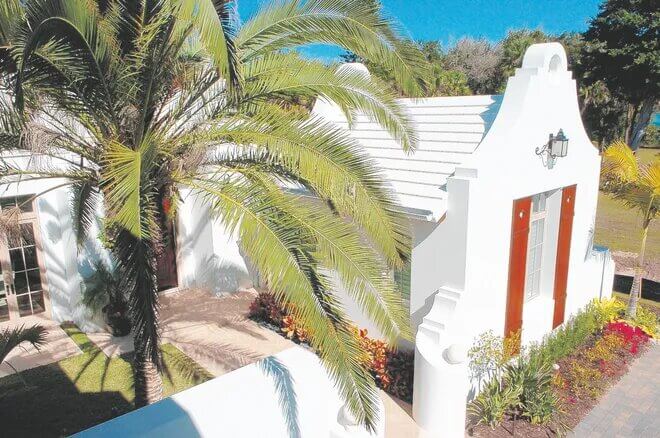Perrone Construction and CMSA architecture were featured sunday morning is a story about a fairly recent arrival for Sarasota architecture. The Dutch West Indies style has gained favor quickly in Sarasota, a traditional style with a casual elegance it is well suited for the Florida lifestyle. Whimsical it has significant curb appeal with very subtle detailing.
Richard Perrone, a 34-year veteran and his son, Ricky, home builders in Sarasota were looking for something new. They had built their share of Mediterranean revival mansions on the water, working with architects on all of them.
But when real estate developer Ken Cox came to them with an 8-acre tract on the south Siesta Key bayfront, near Sanderling Club, they broke with that tradition. After talking Cox out of going with a Victorian style for Spice Bay — “We’d never seen it done on the key, and thought it would fail,” said Ricky Perrone — the Perrones flew to Aruba, Bonaire and Curacao, off the northern coast of South America, to investigate the Dutch architecture there; all three are part of the Kingdom of The Netherlands. The home builders came back with notes and photos and presented them to architects Clifford Scholz of Sarasota and John Cooney of Naples.
Scholz designed a British West Indies model for Perrone Construction at Cox’s 14-lot Spice Bay. To gain attention, the Perrones entered it in at least two Parade of Homes events. The house was purchased and is now for resale at $2.4 million through RE/MAX Alliance Group.
Act II went to Cooney. He designed a gleaming white, 4,000-square-foot spec house in the Dutch West Indies motif, complete with thick walls, rounded parapet, flat-tile roofs, casement windows with transoms and wood shutters, and a courtyard entry.
Perrone finished the house a year ago and sold it five months ago to Debra Losch for $2.5 million.
“I loved it the moment I saw it,” said Losch, an interior designer in Sarasota.
The Perrones have another Dutch house under construction at Spice Bay, and a third is being built by Perrone Construction’s sister company. These aren’t the only Dutch West Indies-inspired homes on the market, though.
In Bradenton’s The Inlets at Riverdale, a model home by Medallion Home/Camlin in the gated Bella Solé section was built in the Dutch theme, although on a smaller scale than the Perrone projects. With about 2,260 square feet, the house is on a canal and was on the market for $560,000, furnished.
While the architecture of the subtropics is gaining traction in the region, with the “Key West” style becoming quite common, British and Dutch architecture is still relatively new here.
It is important, says Scholz, the architect, not to botch things with too heavy a hand.
“You can really ruin the proportions of West Indies or Dutch architecture pretty quickly if you don’t know what you are doing,” said Scholz, who earned his architectural wings designing precise Georgian homes and buildings at The Oaks in Osprey, alongside Bo MacEwen, the master.
Roof proportions are a common cause of error, said Scholz. The roof peaks have no cap tiles, creating “a very clean look that costs less money.” But the angles have to be correct. “It’s little things like that, that clients are drawn to.”
While Scholz designed the British West Indies houses, he has studied the Dutch architecture, especially during a recent trip to Amsterdam, The Netherlands. Seeing and experiencing an unfamiliar architectural language is the key to building with it, he said.
“The British West Indies is more regimented, not quite as whimsical” as the Dutch, he said. “A little more detail-oriented, but in a different way. Dutch architecture has detail in a broader sense. The British West Indies came from Georgian architecture and is more organized and lined up.
“The Dutch architecture has a scale … the density is different,” Scholz said. “The Dutch have a way of whimsically taking something that is straight and pushing or pulling it into a shape that is light and different and fun.
“But its basis, to me, is from the Greeks and Georgian architecture in the proportions.”
Said Losch, the homeowner of the Dutch house: “It is very light and bright and airy; it makes you smile when you walk in the door.”
‘Start right, stay right’
Ricky Perrone said his company works with architects because the first step of construction is the most important.
The company’s slogan is “Start right, stay right.” (Guidelines penciled on the floors and walls of the under-construction houses keep subcontractors square and level.)
Selecting the right architect is not just a matter of style.
“Personalities come into play, too,” said Perrone, “because you are working with this person for awhile.”
“That whole development has been really enjoyable,” said Scholz of Spice Bay. “I have worked Rich Perrone for 30 years, and he was determined to keep a high level of architecture there. It is paying off now. You are going to have a community similar to the way The Oaks started, with an extremely high level of architecture.
“It is appealing and keeps your home values up. Good architecture never looks dated.”
Although the Perrones built Losch’s house as a spec home, they have a more elegant name for it. “We call them character homes,” said Ricky Perrone. “We like to keep a character home going to show off our quality, although we do not have one at this time.”
Most Perrone houses cost between $2 million and $3 million, excluding the cost of the land.
“There is a big uptick in people looking to build,” said Perrone. “We had seen people who wanted to build but were not ready to act. Now we are seeing clients who want to get started right away. There is confidence.”



